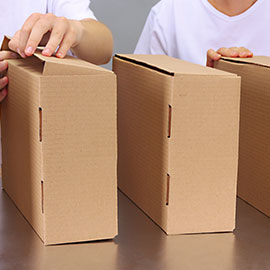Self-storage units don’t have to be a space you visit once or twice a year to dig something out of a stack of boxes. They can be highly organized, easily accessible spaces that free up necessary space in your home or office. To get the most out of them, though, it is best to plan ahead before you start loading up the truck.
Here are steps to help you plan:

Step 1: Plan What You Will Store
- Start by identifying items that will be packed in boxes and stacked.
- Prioritize boxed items you will want to access most frequently (they’ll go closer to the front of the unit).
- Group by fragility or weight – heavier, sturdier items should be stored on the bottom of stacked items, fragile items on top.
- Consider awkwardly-sized items that won’t stack well, including how often you will need to use them, and how heavy they are.

Step 2: Choose the Right Size Unit
Nobody wants to pay for storage they don’t need. But a little extra space makes moving around within the unit much easier. It also gives you room to add those unplanned items that always seem to pop up.
Storage facility managers can be quite helpful in determining how much space you will need.
Step 3: Organize and Pack Your Items with a Plan in Mind
Organizing and efficiently packing your items will take time and concentration. However, the up-front effort will be well worth it when you’re able to easily unload and organize your items at the storage unit. Here are some tips for packing:
Invest in supplies
- Invest in good quality, sturdy boxes and packing materials
- For wrapping breakables, paper will do, but bubble wrap can be used repeatedly, is cleaner, and because it is transparent, makes identifying contents easier.
- Most people end up needing more tape than they thought they would when packing

Packing in Boxes
- Box up everything that you can. Anything left unboxed in a self-storage facility can get dusty.
- Fill boxes to capacity. The contents in half-empty boxes can shift during transport or lifting.
- Distribute the weight in packed boxes evenly. Make sure they are not too heavy for you and others who may be lifting them.
- Wrap all fragile items and breakables such as dishes, glasses, ornaments, etc. separately.
- Clearly label all boxes on more than one side so you can easily identify the contents.
- Pack books flat to avoid damaging their spines.
Packing Other Items
- If you plan to store clothes, think about investing in a wardrobe box with a built-in hanging rod.
- Separate lamp bases and lampshades and wrap them for protection.
- If you’re storing upholstered products such as mattresses and sofas, consider investing in covers, bags or sheeting for additional protection.
- Vacuum-sealed bags work really well for draperies, bedding, and clothing.
- Disassemble furniture such as beds and tables before you store them.
- Spray your wood furniture with a good quality furniture polish before storing it to give it some added protection.
- When storing an oven as well as a refrigerator, enclose the exposed back area of the appliances to prevent vermin.
As you go, keep an inventory of every item you’ve packed. Ideally, include an estimate of the replacement value of each item you store. Consider taking pictures of valuable items. These steps will help you make accurate insurance claims in case of unforeseen damage or loss.
Step 4: Unpack and Arrange Items Efficiently
Before you load up the truck to take your packed items to your self-storage unit, check with the storage facility manager to make sure there is adequate space for the truck to maneuver to your unit.
As you arrive at the facility and begin to unload, arranging your furniture, equipment, boxes, and other odds-and-ends efficiently in your storage unit will make a big difference in maximizing its convenience.